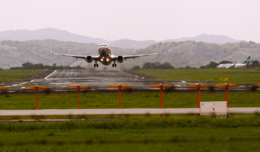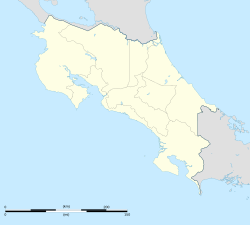Liberia, Costa Rica facts for kids
Quick facts for kids
Liberia
|
||
|---|---|---|
|
District
|
||
|
Images, from top down, left to right: Immaculate Church of Concepcion de Maria, Central Park, Daniel Oduber Quirós International Airport, the Chorotega, Mario Cañas Ruiz Park Monument.
|
||
|
||
| Motto(s): | ||
| Country | Costa Rica | |
| Province | Guanacaste | |
| Canton | Liberia | |
| Founded | 1836 | |
| Area | ||
| • Total | 561.57 km2 (216.82 sq mi) | |
| Elevation | 144 m (472 ft) | |
| Population
(2011)
|
||
| • Total | 53,382 | |
| • Density | 95.0585/km2 (246.200/sq mi) | |
| Demonym(s) | Liberiano | |
| Time zone | UTC−06:00 | |
| Postal code |
50101
|
|
Liberia is the largest city in the Guanacaste Province of Costa Rica. It is located about 215 kilometers (134 miles) northwest of San José, the country's capital. Liberia is an important center for tourism in Costa Rica.
People sometimes call Liberia la ciudad blanca, which means "the white city." This nickname came from the white gravel used for its roads long ago. Also, many old houses in the city used to be painted white. In 2013, Liberia had a population of about 56,899 people.
Contents
History of Liberia
How Liberia Began
Liberia started as a simple resting place on September 4, 1769. It was not officially founded as a town at first. This spot was important because roads from other towns like Rivas, Bagaces, and Nicoya met there. Travelers often stopped to rest. The huge guanacaste trees in the area gave shade to people and their animals. Because of these trees, the area became known as Guanacaste.
Joining Costa Rica
The history of this area is connected to both Nicaragua and Costa Rica. In 1812, a group called the Cortes of Cádiz created one large area that included Nicaragua and Costa Rica. They made León, Nicaragua, its capital. Both Nicaragua and Costa Rica became independent from Spain in 1821.
After a short time as part of the First Mexican Empire (1821–1823), Costa Rica joined the new Federal Republic of Central America in 1823. The area known as the Partido de Nicoya was a part of this republic. This area included most of what is now the Guanacaste Province. Many towns in this area, like Nicoya and Santa Cruz, had strong business ties with Costa Rica. However, the settlement of Guanacaste (which is now Liberia) was more connected to Nicaragua.
On July 25, 1824, the towns of Nicoya and Santa Cruz voted to become part of Costa Rica. But the people of Guanacaste (Liberia) wanted to stay with Nicaragua. After some disagreements, the government of the Federal Republic of Central America decided in 1826 that Guanacaste would join Costa Rica.
Changes to the City's Name
The village of Guanacaste grew and became more important than Nicoya. On July 23, 1831, it was officially named Villa de Guanacaste. A few years later, on September 3, 1836, it became Ciudad de Guanacaste (City of Guanacaste).
In 1838, Costa Rica became an independent country. On December 7, 1848, Costa Rica divided its land into provinces, cantons, and districts. The area including Nicoya, Bagaces, Santa Cruz, Guanacaste (Liberia), and Cañas became the new province of Guanacaste.
On May 30, 1854, the name of Ciudad de Guanacaste was changed to Ciudad de Liberia (City of Liberia). The province's name was also changed to Moracia, honoring the president at the time, Juan Rafael Mora Porras.
Later, in 1859, President Juan Rafael Mora Porras was removed from power. In 1860, the new president, Dr. Jose Maria Montealegre, changed the province's name back to Guanacaste. However, he kept the name City of Liberia.
Celebrating Annexation Day
Today, Costa Rica celebrates the "Annexation of Guanacaste" every year on July 25. This day marks when the province officially became part of Costa Rica. Liberia, as the capital of Guanacaste, holds a big festival. You can see folk dances, parades, cattle shows, and enjoy local food. Traditional "marimba" music is very popular. There's also a parade where children wear masks and costumes.
Liberia continued to grow as a center for farming and raising animals. The building of the Pan-American Highway made Liberia even more important for trade. By the late 1900s, it became a key stop for tourists visiting the Pacific Coast beaches of Guanacaste.
Geography and Population
Geographical Features
Liberia covers an area of about 563.57 square kilometers (217.6 square miles). It is located at an elevation of 144 meters (472 feet) above sea level.
Population Details
| Historical population | |||
|---|---|---|---|
| Census | Pop. | %± | |
| 1883 | 1,710 | — | |
| 1892 | 2,226 | 30.2% | |
| 1927 | 3,161 | 42.0% | |
| 1950 | 4,597 | 45.4% | |
| 1963 | 10,217 | 122.3% | |
| 1973 | 16,823 | 64.7% | |
| 1984 | 22,525 | 33.9% | |
| 2000 | 39,242 | 74.2% | |
| 2011 | 53,382 | 36.0% | |
|
Instituto Nacional de Estadística y Censos |
|||
According to the 2011 census, Liberia had a population of 53,382 people.
Things to See and Do
Liberia is a busy city with over 50,000 residents. It is the main hub for the northwest part of Costa Rica. The city center has a modern church, like many towns in Costa Rica. It faces a main square, called a plaza, surrounded by local shops and restaurants.
In July, Liberia hosts an expo to celebrate the annexation of Guanacaste Province. This event takes place on July 25, 1824.
Museums and Parks
The Museo de Guanacaste is in the heart of Liberia. It shows the culture of Costa Rica and celebrates the country's choice to not have a military. The museum displays works by local and national artists. Volunteers from all over the world help restore the building and protect its cultural history.
Another interesting place is the Museo de Sabanero, also located in Liberia.
Just northeast of Liberia, you can find Rincón de la Vieja Volcano National Park. This park has volcanic hot springs, bubbling clay pots, and many waterfalls. You can explore these natural wonders on the park's hiking trails. There are also hot springs southeast of Liberia, near the Miravalles volcano.
Wildlife and Beaches
Tourists often pass through Liberia on their way to beautiful Pacific Coast beaches. Some popular beaches include Playa del Coco, Playa Hermosa, Playa Tamarindo, and the Papagayo Peninsula.
About 4 kilometers (2.5 miles) south of Liberia, there is an African safari-style attraction called "Africa Mia." Here you can see different animals.
Transportation in Liberia
Roads Connecting the City
Liberia is well-connected by roads. The main routes include:
Liberia's International Airport
The Daniel Oduber Quirós International Airport is located about 13 kilometers (8 miles) west of the city. It is the second international airport in Costa Rica. The first is the Juan Santamaría International Airport in San José. Liberia's airport has flights to many cities in the United States, Canada, London, and Amsterdam.
This airport is very close to some of Guanacaste province's most beautiful beaches. These include Tamarindo, Nosara, Sámara, Carrillo, Playa del Coco, Montezuma, Malpaís, and Santa Teresa.
The Liberia River also shares its name with the town.
Sports in Liberia
The city's main football (soccer) team is Municipal Liberia. They have played for almost 10 years in the top Costa Rican league, the Costa Rican Primera División. They play their home games at the Estadio Edgardo Baltodano Briceño.
Climate in Liberia
Understanding the Seasons
Liberia, like most of Costa Rica outside the Caribbean coast, has two main seasons: the "dry" season and the "wet" season.
The dry season runs from November to April. During this time, temperatures are high, and there is very little to no rain. The wet season is from May to October, when it often rains across the country. However, Liberia is one of the drier cities in Guanacaste province. It gets much less rain than other parts of Costa Rica, even during the wet season.
If you are planning to visit, the best time might be at the start of the dry season. The weather is just starting to get warm, and the rain from the wet season has decreased. The dry season can become very hot, which might be uncomfortable if you are not used to dry heat.
| Climate data for Liberia, Costa Rica | |||||||||||||
|---|---|---|---|---|---|---|---|---|---|---|---|---|---|
| Month | Jan | Feb | Mar | Apr | May | Jun | Jul | Aug | Sep | Oct | Nov | Dec | Year |
| Mean daily maximum °C (°F) | 33.4 (92.1) |
34.4 (93.9) |
35.4 (95.7) |
35.9 (96.6) |
33.9 (93.0) |
32.0 (89.6) |
32.1 (89.8) |
32.1 (89.8) |
31.3 (88.3) |
30.9 (87.6) |
31.6 (88.9) |
32.5 (90.5) |
33.0 (91.4) |
| Daily mean °C (°F) | 25.8 (78.4) |
26.7 (80.1) |
27.3 (81.1) |
28.5 (83.3) |
28.7 (83.7) |
28.0 (82.4) |
27.6 (81.7) |
27.0 (80.6) |
27.2 (81.0) |
27.0 (80.6) |
26.2 (79.2) |
25.7 (78.3) |
27.1 (80.8) |
| Mean daily minimum °C (°F) | 20.7 (69.3) |
21.1 (70.0) |
21.6 (70.9) |
22.7 (72.9) |
23.4 (74.1) |
23.2 (73.8) |
22.8 (73.0) |
22.6 (72.7) |
22.4 (72.3) |
22.3 (72.1) |
21.5 (70.7) |
21.0 (69.8) |
22.1 (71.8) |
| Average rainfall mm (inches) | 1.3 (0.05) |
1.6 (0.06) |
4.1 (0.16) |
23.9 (0.94) |
194.1 (7.64) |
245.6 (9.67) |
153.3 (6.04) |
209.4 (8.24) |
346.3 (13.63) |
310.0 (12.20) |
98.2 (3.87) |
12.3 (0.48) |
1,600.1 (62.98) |
| Average rainy days (≥ 1.0 mm) | 0 | 0 | 0 | 1 | 9 | 14 | 10 | 12 | 17 | 16 | 6 | 2 | 87 |
| Average relative humidity (%) | 65.3 | 62.2 | 60.5 | 62.0 | 73.2 | 81.9 | 78.4 | 80.9 | 85.4 | 86.1 | 80.4 | 72.1 | 74.0 |
| Average dew point °C (°F) | 18.8 (65.8) |
18.9 (66.0) |
19.0 (66.2) |
20.5 (68.9) |
23.4 (74.1) |
24.6 (76.3) |
23.5 (74.3) |
23.4 (74.1) |
24.5 (76.1) |
24.5 (76.1) |
22.6 (72.7) |
20.3 (68.5) |
22.0 (71.6) |
| Mean monthly sunshine hours | 297.6 | 276.9 | 303.8 | 267.0 | 204.6 | 168.0 | 186.0 | 182.9 | 159.0 | 170.5 | 204.0 | 260.4 | 2,680.7 |
| Mean daily sunshine hours | 9.6 | 9.8 | 9.8 | 8.9 | 6.6 | 5.6 | 6.0 | 5.9 | 5.3 | 5.5 | 6.8 | 8.4 | 7.4 |
| Source: Instituto Meteorologico Nacional (precipitation 1957–2012, temperatures 1977–2013, sun 1976–2012, humidity 1976–2013) | |||||||||||||
Notable People from Liberia
- José Carlos Sáenz Esquivel
- Cristian Gamboa
- Levi Vega Martinez
See also
 In Spanish: Liberia (Costa Rica) para niños
In Spanish: Liberia (Costa Rica) para niños








